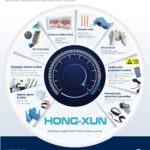How the Humble Inkjet Printer is the New Go-To in Organ Transplantation
When we think of inkjet printers, most of us picture them churning out documents, photos, or school projects. But what if we told you that the same technology behind printing paper is now helping save lives? Yes, inkjet printers have evolved far beyond office supply status – they’re now pioneering a new frontier in organ transplantation.
This incredible leap from printing ink to "printing" human tissues is revolutionizing the medical field, and here's how.
From Paper to Tissue: The Birth of Bioprinting
The idea of using a printer to create human tissues might sound like science fiction, but it’s real – and it’s happening now. The key innovation here is bioprinting, a specialized form of 3D printing that uses living cells instead of ink.
The technology behind bioprinting is remarkably similar to that of your standard inkjet printer. Instead of cartridges filled with ink, however, bioprinters are loaded with bio-ink – a combination of living cells and gel-like substances that support the cells. Layer by layer, these printers deposit the bio-ink, eventually building a 3D structure that mimics human tissue.
The Role of Inkjet Technology in Bioprinting
You might wonder how the humble inkjet printer comes into play. Surprisingly, it’s the perfect starting point for bioprinting. Inkjet printing technology is precise, affordable, and easily adaptable for medical applications. It allows for the meticulous control needed to deposit cells in the right position, maintaining the integrity of complex tissue structures.
Inkjet bioprinters, for example, can print cells drop by drop, much like traditional printers deposit ink on paper. This level of precision is crucial for creating viable tissues that can function like real human organs.
Organ Transplantation: Bridging the Gap with Bioprinting
The greatest challenge in organ transplantation today is the severe shortage of donor organs. Thousands of people around the world die every year waiting for a suitable organ, and even when organs are available, rejection by the recipient’s immune system remains a major issue.
Bioprinting offers a groundbreaking solution to both problems:
- Personalized Organs: One of the most exciting possibilities with bioprinting is creating custom organs using the patient’s own cells. By using a patient’s stem cells to print tissue, doctors can develop an organ that is genetically identical to the recipient, drastically reducing the risk of rejection.
- Scalable Solutions: While creating entire organs is still in the research phase, bioprinting is already being used to print tissues that can aid in recovery or function in place of damaged areas. Researchers are currently developing tissues for heart patches, liver grafts, and even kidney tissue.
- Tissue Repair and Testing: While we’re not quite at the point of printing fully functional organs, the technology is already in use for printing skin grafts for burn victims, cartilage for joint repair, and even tissues for drug testing and disease research.
Inkjet Printers in Action: Recent Breakthroughs
The transformation of inkjet printing into medical marvels has already led to significant breakthroughs:
- Printed Skin Grafts: Researchers have used inkjet-based bioprinters to print skin grafts for burn victims. This technology allows doctors to print layers of skin, complete with blood vessels, that can be applied directly to wounds.
- 3D Printed Heart Patches: Scientists have been working on using inkjet printers to print heart patches, which can be placed on damaged hearts after a heart attack to help regenerate tissue.
- Functional Organoids: Some labs have successfully printed miniature organs known as organoids, which are being used to study diseases and test drugs in ways that are impossible with traditional methods.
What’s Next for Inkjet Bioprinting in Transplantation?
The future of bioprinting is incredibly exciting. While printing fully functional organs like hearts, lungs, and kidneys is still a few years away, the progress being made in creating smaller, simpler tissues suggests that this breakthrough is closer than we think.
As researchers continue to refine the technology, the day may come when waiting lists for organ transplants are a thing of the past, and patients in need of new organs will simply have them printed on demand – customized for their unique body and biology.
Conclusion: A Printing Revolution Like No Other
The inkjet printer, once a staple of offices and homes, is now becoming one of the most powerful tools in modern medicine. Its transformation from printing paper to printing human tissue showcases the potential of combining innovation with everyday technology.
The journey from humble inkjet to life-saving bioprinter is a testament to how far we’ve come – and a glimpse of how far we can go. As research continues, the humble inkjet printer may soon become the new go-to for organ transplantation, transforming lives and rewriting the future of medicine.



